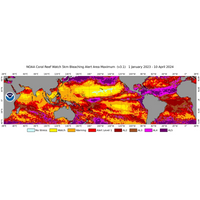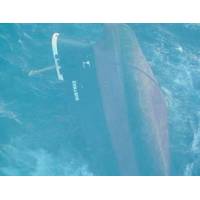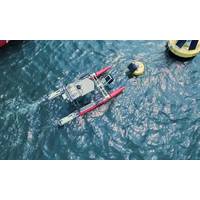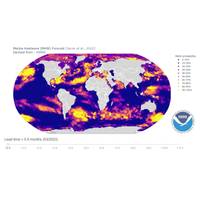
Global Coral Bleaching Crisis Spreading
cause corals to expel the colorful algae living in their tissues. Without the algae's help in delivering nutrients to the corals, the corals cannot survive.The world's fourth mass bleaching event, which scientists declared one year ago, has shown few signs of slowing down, according to the International Coral Reef Initiative and data from the U.S. National Oceanic and Atmospheric Administration which track reef health. Instead, it has grown to be the most widespread on record, with 84% of reef areas - from the Indian Ocean to the Atlantic to the Pacific - subjected to intense heat stress for a

Hottest Oceans in 400 Years Threaten Great Barrier Reef
shorelines from erosion, are home to thousands of species of fish, and are an important source of tourism revenue in many countries.At least 54 countries and regions have experienced mass bleaching of their reefs since February 2023 as climate change warms the ocean's surface waters, the U.S. National Oceanic and Atmospheric Administration (NOAA) has said.The Great Barrier Reef is not currently on UNESCO's list of world heritage sites that are in danger, though the UN recommends it should be added.Australia has lobbied for years to keep the reef - which contributes A$6.4 billion ($4.2 billion)

Coral Bleachings Devastate Bali Reefs as Sea Temperatures Rise
were bleached in less than 10 years, he says, blaming warmer sea temperatures triggered by climate change.Coral bleaching occurs when coral expels the colourful algae living in its tissues. Without the algae the coral becomes pale and vulnerable to starvation, disease or death.In April, the U.S. National Oceanic and Atmospheric Administration (NOAA) said more than 54% of the reef areas in the world's oceans are experiencing bleaching-level heat stress, the fourth global bleaching event in the last three decades.Indonesia has roughly 5.1 million hectares of coral reefs and accounts for 18% of

More Than 60% of World's Coral Reefs May Have Bleached in Past Year
Nearly two-thirds of the world's coral reefs have been subjected to heat stress bad enough to trigger bleaching over the past year, the leading agency monitoring coral reefs said on Thursday.The U.S. National Oceanic and Atmospheric Administration (NOAA) announced last month that the world's coral reefs were in the throes of a fourth mass bleaching event, as climate change combined with an El Nino climate pattern has pushed ocean temperatures to record highs.Now, the agency reports some 60.5% of the world's reef area has been affected and that number is still rising."I am very worried

Coral Reefs Suffer Fourth Global Bleaching Event
white in what scientists said on Monday amounted to the fourth global bleaching event in the last three decades.At least 54 countries and territories have experienced mass bleaching among their reefs since February 2023 as climate change warms the ocean's surface waters, according to the U.S. National Oceanic and Atmospheric Administration's (NOAA) Coral Reef Watch, the world's top coral reef monitoring body.Bleaching is triggered by water temperature anomalies that cause corals to expel the colorful algae living in their tissues. Without the algae's help in delivering nutrients to

Rubymar Sinking Puts Coral Reefs At Risk
water body, receiving few artificial inputs from urban wastewater discharge and aquaculture operations."If you suddenly have a huge amount of fertiliser dumped into the ocean, you're probably going to have some pretty drastic algal blooms," said Derek Manzello, who coordinates the U.S. National Oceanic and Atmospheric Administration's Coral Reef Watch.Studies suggest that because corals there are already specially adapted to warm water conditions, they may be more resilient to rising ocean temperatures, requiring greater temperature anomalies to bleach - the process by which corals

NOAA Chooses OPT for Uncrewed Maritime Systems Services
Ocean Power Technologies (OPT) announced the award of three separate Indefinite Delivery Indefinite Quantity (IDIQ) Multiple-Award Contracts (MAC) from the U.S. National Oceanic and Atmospheric Administration (NOAA). NOAA has selected OPT as one of several Multiple Award IDIQ contract holders to provide Uncrewed Maritime Systems (UMS) Services to NOAA's Office of Marine and Aviation Operations (OMAO), Uncrewed Systems Operation Center (UxSOC). According to OPT, these contracts have the potential to result in millions of dollars of revenue for OPT, and the ordering period is set to span

Philippines Finds Sunken Fuel Tanker 3 Weeks after Spill
;oil slick, according to Filipino marine scientists.Japan has also sent a team of coast guard personnel to help in the cleanup, according to the Philippines' disaster agency, while five U.S. coast guard personnel have arrived to help with the spill response, the U.S. embassy said.The U.S. National Oceanic and Atmospheric Administration will work closely with the Philippines to conduct rapid environmental assessments of affected areas and assess needs for ecosystem restoration, the embassy said.The Philippines' environment ministry said it was also in talks with other Southeast Asian countries

Marine Heatwaves Are Sweeping the Seafloor Around North America
Heatwaves unfolding on the bottom of the ocean can be more intense and last longer than those on the sea surface, new research suggests, but such extremes in the deep ocean are often overlooked.A team of scientists with the U.S. National Oceanic and Atmospheric Administration have conducted the first assessment of marine heatwaves along North America's continental shelves.They found that these bottom heatwaves ranged from 0.5 degrees Celisus to 3C warmer than normal temperatures and could last more than six months — much longer than heatwaves at the surface."We simply don't have a



 February 2025
February 2025





